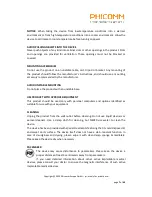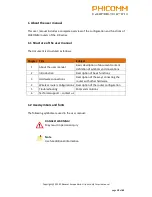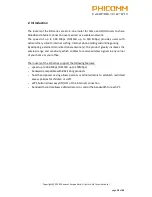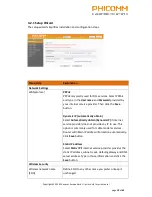
Copyright @ 2014 Phicomm Europe GmbH – print only for private use!
page
4
of
49
Hearing experts suggest that to protect your hearing:
•
Limit the amount of time you use receiver, headphones, speakerphone or earpieces
at high volume.
•
Avoid turning up the volume to block out noisy surroundings.
•
Turn the volume down if you cannot hear people speaking near you.
SAFETY PRECAUTION FOR DIRECT SUNLIGHT
Keep this product away from excessive moisture and extreme temperatures. The device
is designed to be operated in temperatures between 0°C and 40°C. Low- or high-
temperature conditions might cause the device to temporarily stop working properly. Do
not leave the product in a vehicle or in places where the temperature may exceed 70°C
(window sill or behind glass). Avoid dramatic changes in temperature or humidity when
using the device as condensation may form on or within the device.
When you are using the device, it is normal for the device to get warm. The exterior of
the device functions as a cooling surface that transfers heat from inside the unit to the
cooler air outside.
ENVIRONMENT RESTRICTIONS
Do not use this product in gas stations, fuel depots, chemical plants or where blasting
operations are in process, or in potentially explosive atmospheres such as below deck on
boats, fuel or chemical transfer or storage facilities, and areas where the air contains
chemicals or particles, such as grain, dust or metal powders. Please be aware that sparks
in such areas could cause an explosion or fire resulting in bodily injury or even death.
EXPLOSIVE ATMOSPHERES
In any area with a potentially explosive atmosphere or where flammable materials exist,
the product should be turned off and the user should obey all signs and instructions.
Sparks in such areas could cause an explosion or fire resulting in bodily injury or even
death. Users are advised not to use the equipment at refueling areas such as service or
gas stations, and are reminded of the need to observe restrictions on the use or radio
equipment in fuel depots, chemical plants or where blasting operations are in progress.
Areas with a potentially explosive atmosphere are often, but not always, clearly marked.
These include fueling areas, below deck on boats, fuel or chemical transfer or storage
facilities, and areas where the air contains chemicals or particles, such as dust or metal
powders.





































